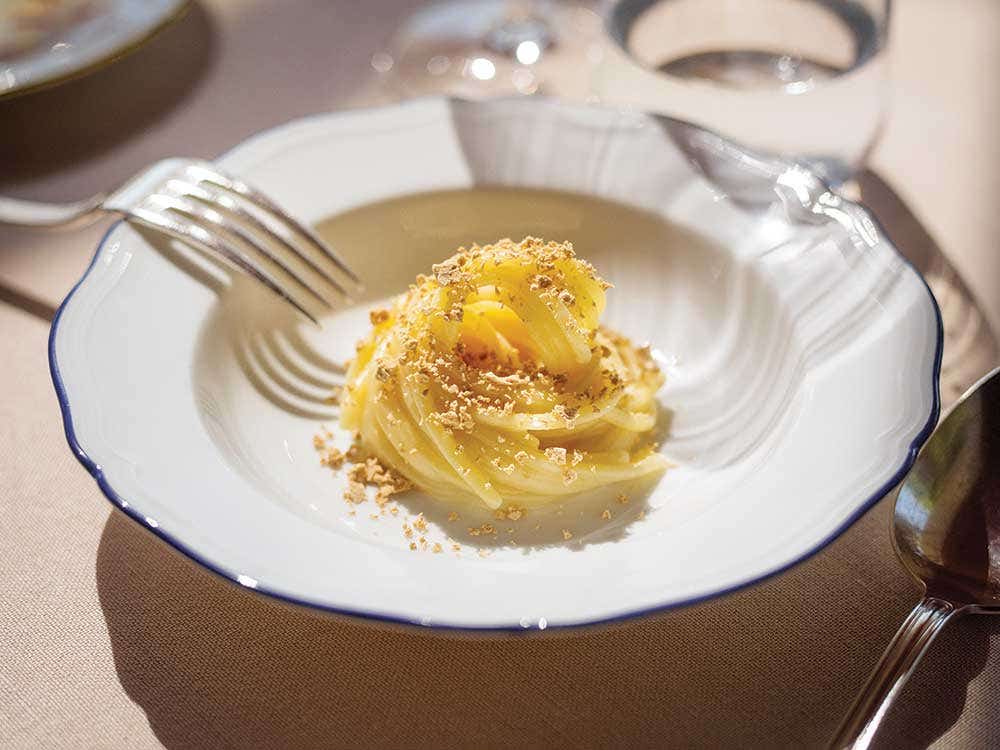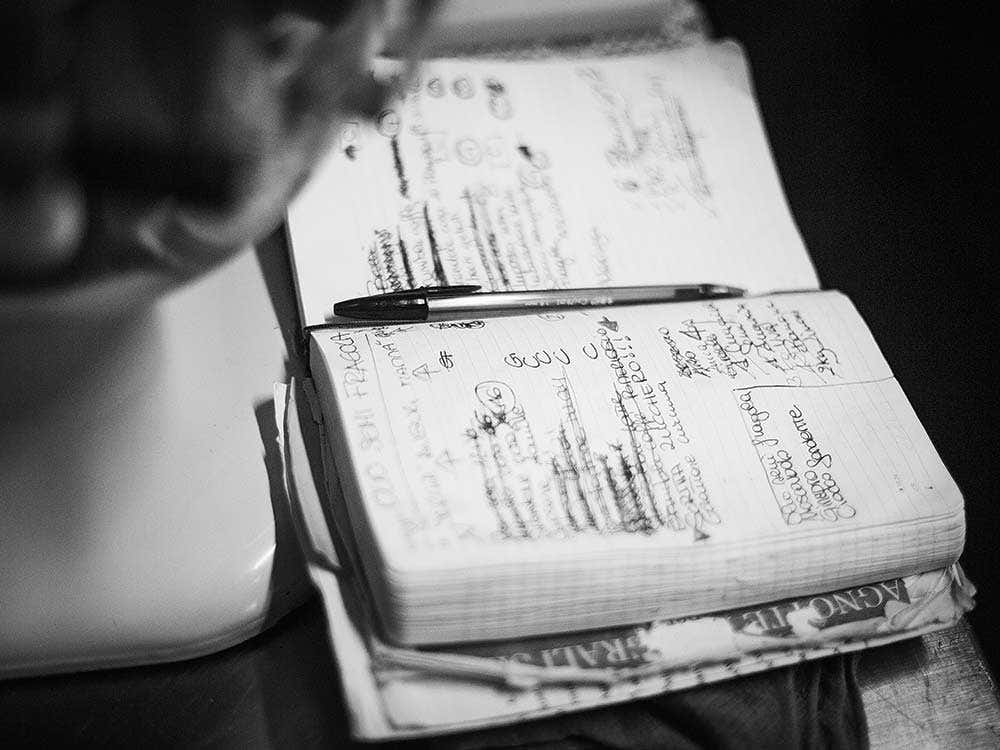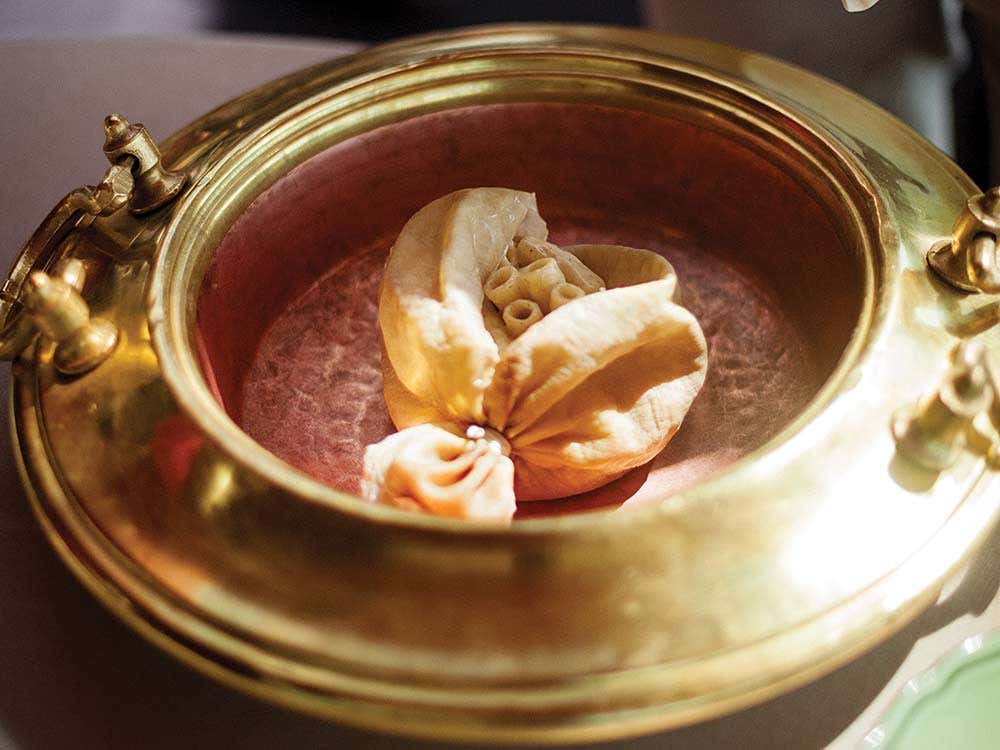
Meet the Pasta Perfectionist Making Waves in Italy
Riccardo Camanini loves spaghetti, and he wants to show you why
Morning in Gardone Riviera is a riot of tidy perfection. Songbirds coo contentedly. Wild sun ricochets off the postcard lake. Spiffy wooden boats dawdle under a cloudless sky. The air tastes delicious. Riccardo Camanini sits on the terrace of his lakeside restaurant, Lido 84, nursing an espresso and talking about his spaghettoni with butter and brewer’s yeast. Spaghettoni is spaghetti’s fat cousin. Camanini gets his from a 120-year-old pastificio called Verrigni, in Abruzzo, 300 miles to the south. They use only Italian-grown wheat and extrude the spaghettoni through dies made of gold rather than industry-standard bronze for reasons that are a little too complex to get into here. When the pasta is nearly done (judged by sight and taste and pushed a little past al dente), Camanini tosses it with Beppino Occelli’s super clean-tasting Piedmontese butter. As the butter-water emulsion is formed, Camanini pulls the spaghettoni from the heat and tops it with a dash of crumbled brewer’s yeast that’s been slowly baked until, he says, “it’s the color of sand and the texture of meringue, with the toasted flavors of nuts and cream.” During service, the waiters will ascribe a nocciola (hazelnut) and brioche fragrance to this trinity of transformed yeast, pure butter, and gold-extruded pasta and they’re not wrong. Nothing is wrong with this pasta. It is all very right: the nutty sweet crunch of the yeast, the creamy pasta-ness of the pasta, the slightly mysterious bread-and-butter effect, and the general deep-brain-warming happy feeling of the whole thing. The semi-pliant spaghettoni will, Camanini hopes, produce a specific sound when chewed. Bald head gleaming in the sun, the chef points at his own cheeks while gyrating his jaw in a slow, exaggerated pantomime of mastication: oomsh, oomsh, oomsh. “If the spaghettoni is too al dente, you just bite it and swallow quickly. But if it’s a little more cooked then it will be more chewy and you’ll mash it more in your mouth. And as you mash it”—oomsh, oomsh, oomsh—“you amplify the flavor of the yeast and the aroma goes in your nose. “But,” he adds, “this is just my opinion.”

Camanini’s opinions regarding pasta have been much discussed and celebrated of late in Italy. After decades spent cooking in the pampered obscurity of a nearby Relais & Châteaux resort, Camanini decided it was time to do his own thing. With his brother Giancarlo, he opened Lido 84 three years ago on a tiny budget with no investors. In their first year they earned a Michelin star. Earlier this year Camanini was awarded “Chef of the Year” by the Italian chef’s organization Identità Golose. The legend of the spaghettoni with brewer’s yeast is that of a seemingly simple plate of pasta that became an unlikely sensation and put a late-blooming, 43-year-old chef in a perfectly lovely but gastronomically unremarkable resort town on the map. “In the beginning, the menu had to be very simple because we didn’t have any money,” says Camanini. “We started with spaghettoni, butter, and lemon. When the local lemon went out of season, we looked around and saw the Cedrus libani”—he points at a clutch of evergreens behind the terrace—“so in April we did spaghettoni, butter, and cedar tips. In May we have chamomile here. So we tried spaghettoni, butter, and chamomile. After the chamomile, what do we do now? It was difficult. For a few days, I did an inventory of everything in the kitchen. Spaghettoni, butter, and a pen? No. Spaghettoni, butter, and a phone? No.”
Out of curiosity (and a lack of promising alternatives) he nibbled some brewer’s yeast. Raw, it was too acidic. Baked in a dry oven for four hours at 72°C (161°F), however, the sour yeast was transformed.
The spaghettoni is a prime example of what Andrea Petrini calls Camanini’s deft, “maximal-minimalist” way with pasta. Petrini, the debonair and maximally opinionated culinary observer and founder of the chef’s collective Gelinaz, was an early and vocal Camanini fan. Petrini says that Alain Ducasse declared the spaghettoni the best pasta he’d ever eaten. “Ducasse told me ‘You cannot add anything because if you do it will ruin the balance. But at the same time, you cannot subtract anything.’ He really fell in love.”
The American chef Corey Lee was similarly smitten. “It’s an example of a chef’s creativity in the best form—something you can appreciate without having to hear the story, without having to appreciate how forward-thinking it is.”
Lee brought the dish back to In Situ, his food-as-art restaurant at the San Francisco Museum of Modern Art where he precisely replicates recipes on loan from great chefs.
“I got lucky,” Camanini says, with unfeigned modesty, gazing out at the pristine blue lake, on which his glass-fronted restaurant sits, shiplike. A single palm tree rises beside it like a mast.
Eleonora Cozzella, food writer for La Repubblica and the author of the book Pasta Revolution, notes Camanini's easygoing confidence. "He's as calm as a monk," she says, "but under this quiet you notice something completely original coming from his brain." She hails the spaghettoni as a "union between classical training and futuristic ideas, a dish of genius."
Let us pause now to observe that Italy is not like anywhere else. This is a tradition-bound culture in which vanishingly slight adaptations—yeast!—are experienced as thrilling, sometimes heretical, potentially revolutionary challenges to the established culinary norms.

And this is probably also a good time to note that topping spaghettoni with yeast is not, by any measure, the most aggressively nonconformist thing Camanini does to a plate of pasta. That distinction is owned by his rigatoni cacio e pepe, which is cooked inside an inflated pig's bladder. A Roman peasant dish given the haute French treatment, in the manner of poularde en vessie (chicken in a bladder), it harkens back to ancient elemental cooking found in the fourth-century Roman texts of Apicius.
Preparing pasta in this manner is a theatrical, high-risk proposition: You can’t see or taste the rigatoni as it pressure-cooks inside the organ. Bladders occasionally explode.
“Each time it can be different,” Camanini says, pleased with the idea. “It’s like when you buy shoes from an artisan, you find these imperfections because they’re handmade. Cuisines need to be like this.”
The remarkable thing about the bladder gambit isn't that it works, but that it yields a supercharged cacio e pepe, with a hint of hard-to-place piggy funk. Camanini presents the bladder tableside, cutting it open and scooping out its fragrant contents.
“Here is one of the poorest peasant dishes,” Petrini observes, “and he is serving it with techniques borrowed from haute cuisine. It’s an extremely clever dish.”
The approach is in line with what the Italian journalist Gabriele Zanatta describes as Camanini’s philosophy of pasta, the belief “that pasta is not just the vehicle of a sauce—as it’s always been in Italy—but it has to have its own personality, which is no less important than the sauce.”
“Camanini renewed my appreciation for pasta in general,” Corey Lee says. “If you think about pasta in a fine-dining context, mostly it’s just paired with expensive ingredients. Tagliatelle with truffles is great but it gets boring after a while.”
Someone drops by offering to sell Camanini a trout. It’s a lovely shiny specimen, fished from the lake earlier this morning. “Bella,” he says, admiring the fish and his good luck. “I am happy.” And, truly, he looks as contented as any chef I’ve ever seen.
Does he ever get bored of pasta?
“I’m Italian!” he says. “For us pasta is regular life.”
He has a special regard for pasta secca, dry pasta, he says, because it is the foundational food. Most mothers make ravioli infrequently but will feed their families spaghetti every day.
When he tries the pasta from a new producer—which he does constantly and with great attention—Camanini eats it simply dressed, a glug of olive oil and nothing else.
“I’m a runner,” he says. “For 15 years I’ve been running. It’s important to be healthy in the kitchen and to eat a very clean diet, which for me means carbs. For lunch and dinner, I eat only pasta, and only with extra-virgin olive oil. So for many years, just to be more happy during my meals, I tasted many, many different kinds of pasta from all over Italy. I have made a training around the purity of the pasta. Training myself about the flavor of dry pasta. It was nice.”
He never varies from the pasta-only routine?
“Sometimes, a peach!” he says, beaming.

In the kitchen, we’re salting the water. How much salt? “We’re Italian. We never measure. Enough to be right.” Timers are outlawed in the kitchen. “You must feel the pasta,” Camanini says. “It’s very important, as an Italian, to look at the pasta as it cooks.” He is walking me through the morning pasta prep. In addition to the spaghettoni and the bladder-cooked rigatoni, there’s a spaghettini with sea urchin; tiny seashell-looking lumachine from Naples served shatteringly al dente with sea anenome and potatoes; and fusilloni (fusilli’s fat cousin) with a bright green sauce made of green merinda tomatoes and puréed raw pistachios. “I prefer dry pasta because it’s not common. In a restaurant like this it would be typical to have just one. We have five on the menu now. Fresh pasta you just boil for a few seconds and serve. It’s much more difficult to do dry pastas well because you need more time to cook each one.” This is something that can be hard for Americans to fully get: that until recently, outside of a limited range of traditional preparations, there hasn’t been a lot of dry pasta happening in certain kinds of fancy Italian restaurants. And at the highest level, there was sometimes no pasta at all, or pasta used in a throwaway manner. “There’s nothing wrong to an Italian about going to a restaurant to eat pasta,” says Andrea Petrini. “The problem was with the Italian fine-dining chefs who were still ashamed of cooking pasta. For a long time, the Italians were living under the influence of French cuisine. Then they discovered Spain and molecular cuisine. Now there is a new generation of chefs like Riccardo who are daring to think that pasta deserves the same attention as any other ingredient or any other dish.”
Gabriele Zanatta recalls: “If you entered an Italian starred restaurant in the ’90s, you wouldn’t have read a single dish of dry pasta on the menu. Spaghetti was a home dish, too popular to be interesting.”
For Camanini—attuned to the nuances between dried pastas, embracing flavors and dishes from outside his home region—this was a kind of shortsighted travesty.
“This isn’t really the Italian style. They lost the memory that Italian dry pasta is about the emulsion.” This is Camanini’s obsession: finding the region and brand and shape of pasta that will best hold its sauce. Italians don’t like too much sauce with their pasta. Camanini pushes this to an extreme. The thin green emulsion of merinda tomatoes and pistachios appears spray-painted onto the curlicue fusilloni. It clings tight as spandex.
There is no puddle of sauce in the bowl. "We tried many different kinds of fusilloni until we found one that stays covered. Did you notice the texture of the pasta? It was like meat. Carnosa—fleshy."
There is usually just one fresh pasta dish on the menu at a time. Today’s offering: buttoni, or little buttons stuffed with a dot of buffalo ricotta, grated lemon, and colatura. The buttons are sandwiched between similarly sized thin disks of just-cooked kohlrabi and topped with a tiny piece of gently cured mackerel, a drizzle of good olive oil, and a bit more salty colatura. The kohlrabi has a bit of bite, like a piece of al dente pasta. It’s an extraordinarily unassuming bite. I mention to Camanini that I can’t think of another preparation in which a stuffed pasta is itself enveloped in another thing.
He can’t either. “But I didn’t think too much about it!” he swears. “I am just happy when a new taste gives me an idea that I can combine together with a pasta.”
Keep Reading
Continue to Next Story










